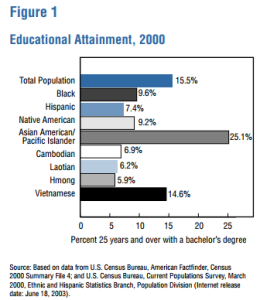I have only ever heard praise for my intelligence and work ethic. It is something that has become internalized and expected of me, and my Asian peers.
The term “model minority” was first coined by sociologist William Peterson in 1966 in an article about Japanese Americans in The New York Times Magazine, lauding their ability to gain success and capital in America. Such a myth is not only problematic in instilling stereotypes, but also reflects a general lack of cultural awareness. The model minority myth is merely one example of societal systemic racism.
The model minority portrayal of success for Asian American Pacific Islanders (AAPIs) labels them as one homogeneous group.
Statistically, I have a 49% probability of gaining a college degree by the age of 25 and earning a median of $68,636, both higher probabilities than those of whites or the national average in 2012.
This statistic not only pertains to my chances but supposedly, the chances of an entire continent that consists of 48 countries. And while the U.S. Census only categorizes 33 Asian languages, China alone has 297 languages and 56 ethnic groups. Despite such a vast variety, the model minority grossly generalizes AAPIs to a one-dimensional, stereotypical character, when 62% of AAPIs are actually more likely to self-identity with their specific country of origin rather than simply as Asian American.
The model minority is a stereotype we have come to accept in American society because it purports a positive and successful complex for Asians; nevertheless, it is still a stereotype, but because it correlates success with a minority group, an unfortunate anomaly in our society, we miss its elusive racist tones. Frank Chin and Jeffery Paul Chan terms these acceptable stereotypes as forms of “racist love.”
The model minority myth is not representative of all AAPIs.
Aggregate, undifferentiated data perpetuate the stereotype that Asians are smart, top of their class, hard workers, and successful when in actuality some AAPIs are still largely uneducated, poor, and victims of discrimination.
Closer studies reveal distinct differences between ethnic populations. As indicated by the following charts, Southeast Asians have education attainment rates similar to and actually lower than Blacks and Hispanics, minority groups largely disadvantaged in areas such as income and education.
Unfortunately, due to the model minority myth, these distinctions are rarely iterated. The danger of “racist love” is that it induces stagnation and does not shed enough light on the situation of Southeast Asians and AAPIs. When we believe in the model minority myth, the institutionalized racism that effects AAPIs remains unrealized and unaddressed.
AAPIs have not reached the same success level as whites.
Even for Asians who appear to be well off, the model minority myth is still hurtful. There is a misconstrued concept that a college degree renders the equivalence to employment success. While the correlation is indeed strongly positive, stepping beyond oversimplified and aggregate data reveals that most Asian Americans are underemployed compared to whites with the same level of education.
For example, a 2011 study revealed that AAPIs with a college degree suffered from a 6.4% unemployment rate when whites with the same educational background only suffered from a 4.3% unemployment rate. In 2012, AAPIs’ poverty rate was 11.7% in comparison to the white poverty rate of 9.7%.
The model minority myth hurts minority groups other than AAPIs.
The model minority myth supports the idea that Asians possess a unique work ethic, which is responsible for their success in America. This imbues AAPIs with a distinct, but false, cultural quality whose connection to success obscures other factors, such as high ethnic capital and immigration status, which may play a role in giving AAPIs an advantage in America. Ignoring these factors suggests that non-Asian minority groups’ lack of success in America is self-imposed and discounts the effects of the systemic racism, racial profiling and white privilege limiting other minorities. Instead, these minorities are construed as lacking both the work ethic and value for education that leads to the model minority’s characteristic success. As a result, their socioeconomic plight is considered their own fault and not as indicative of our society’s racial issues.
The model minority myth conveys the message that other minorities fail to succeed because they do not work hard enough, and this is incorrect.
What should we do?
While we should not ignore the context of culture in shaping people’s experiences, the model minority myth dangerously oversimplifies Asian culture and indicates a lack of understanding and appreciation for the heterogeneity of AAPI ethnic groups.
In order to further progress racial justice, we need to move away from the model minority mindset and embrace the individuality of AAPIs. We must recognize the systemic changes that still need to happen.



